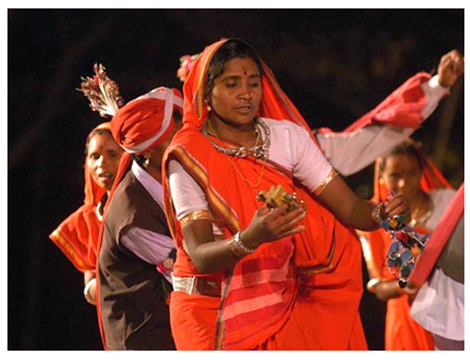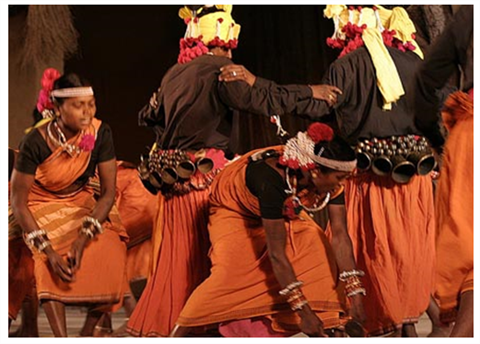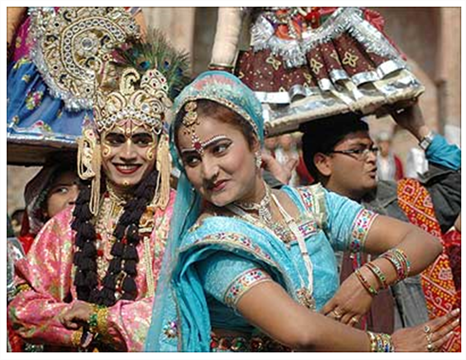FOLK DANCES OF MADHYA PRADESH
Contents
· Gaur Dance
· Muria Dance
· Saila Dance
· Karma Dance
· Kaksar Dance
· Chaitra Festival Dance
· Sua or Sugga Dance
· Other Dances
· Folk-dances of Nomadic Tribes
· The Attire
Gaur Dance
The Gaur dance is one of the most popular dances of Madhya Pradesh. The Gaur dance literally means the dance of the ferocious bisons, which symbolizes the hunting spirit of the tribals. This dance is especially performed by the Sing Marias or the Tallaguda Marias.
The dance begins with the sounding of a bamboo trumpet or horn. The costumes for the dances are also very elaborate. The head dresses are frilled with cowries and plumes of peacock feather. The men folk carry flutes and drums, which accompany the dance performance. Soon, the female dancers, adorned with beaded necklaces and brass fillets join the assemblage and perform along with the male dancers. During the performance, a number of bison movements are imitated. They hurl wisps of grass into the air, with a charging attitude and tossing of the horns.
Muria Dance
The Murias dwelling in the North Bastar region are trained in the Ghotul, to perform all kinds of community dances. Lingo Pen is the phallic deity of the Muria tribe and it is believed that it is Lingo Pen, who taught all the young boys and girls the art of drumming. Lingo Pen is also considered as the founder of the Ghotul institution. Thus, before commencing any auspicious occasion such as a marriage or any other festival, Lingo Pen is invoked and the drums are worshipped.
The Murias of North Bastar are trained in the Ghotul for all types of their community dances. Before any dance is commenced at a wedding or a festive occasion, the Murias first worship their drums. Very often they begin with an invocation to 'Lingo Pen', the phallic deity of the tribe and the founder of the Ghotul institution. To a Muria, Lingo Pen was the first musician who taught the art of drumming to the tribal boys.
The dancing sites are generally the Ghotul compound. Har Endanna is a very popular ritualistic dance performed in the marriages, played by both girls and boys during the marriage ceremonies.
The Hulki dance is one of the loveliest dances of Madhya Pradesh and is performed by both boys and girls. It is also performed durng the occasion of marriage. The Pus Kolang and the Chhat-Dadar expeditions are also performed by the enthusiastic young boys and girls of Madhya Pradesh.
Saila Dance
The Saila dance is a form of stick dance and is very popular among the people of Sarguja, Baitul and Chhindwara districts. In some of the regions, Saila dance is also known as Dandar Pate or Danda Nach. The dancers usually stand on one foot and hold onto the next dancer. Then, they all hop and dance together. The Snake dance is the climax of the Saila dance.
There are many different varieties of Snake dance such as Thadi Saila, Shikari Saila, Chakramar Saila, Artari Saila and Chamka Kunda Saila. The Dasera dance is also performed by the Baigas, before the occasion of Diwali. The Ahirs of the region also perform another kind of dance known as the Danda dance.
Karma Dance
The Karma dance is directly associated with the fertility cult and Karma festival celebrated in the month of August. Karma dance is especially popular with the Gonds and Baigas of Chhatisgarh and the Oraons of north-western Madhya Pradesh. The Karma dance is one of the oldest dance forms of the Adivasis of Madhya Pradesh and also is the most popular among them.
The Majhwars of the Sarguja district perform the dance at the end of the rainy season, while the Baigas and the Gonds performs the dance at any time of the year. Some of the variants of the Karma dance are as follows:
- Jhumar
- Ghatwar
- Ektaria
- Pendehar
- Dohoari
- Lahaki
- Tegwani
- Thadi
- Lahaki
- Khalha
- Jharpat
- Jhumar
Kaksar Dance
The Kaksar dance is performed by the Abhujmarias of the hilly region of Bastar, to invoke the deity for a rich harvest. The melodious tunes and the tinkling of the bells during the performance of the dance, creates an enchanting atmoshphere. Both young boys and girls participate enthusiastically in the dance and they get a unique opportunity to choose their life partners during this performance. There is an abundance of rhythm and melody in this dance form.
Chaitra Festival Dance
The Chaitra festival dance is performed after the reaping of the harvests, to thank Goddess Annapurna for the harvest and seek her blessings for a good harvest the following year. The men and women dance after forming a circle or a semi-circle, while all the dancers hold onto each others waists.
The dancers sport a peacock feather on their heads and wear colourful costumes, and garlands of shells and pearls. The music of Nagada, Shehnai, Timki, Dholak, Maduri, Kohuk, Singha and Tapri accompany the dance.
Sua or Sugga Dance
The Sua or Sugga dance literally menas the dance of the parrots. It is especially popular amongst the women of Chattisgarh and the Mikal Hills. The women make imaginative movements of their feet, imitating the flight of the parrots and also bend and jerk their heads in a bird like fashion. Wooden parrot dummies are made and placed on wooden platforms, covered with paddy shoots. A wooden clapper called Thiski is also played to provide rhythm to the entire performance.
Other Dances
The major dances are as follows:
- Bhagoriah dance
- Gavar dance
- Ger dance
- Pali dance
Folk-dances of Nomadic Tribes
Lehangi Dance
The Lehangi dance is usually performed in the middle of the rainy season. This dance is usually performed by young men with sticks in their hands. The Banjaras of Nimad perform the Lehangi dance during the festival of Holi. The Kanjar perform serious acrobatic tricks during these performances. The Banjara women deck up heavily during the performances, with silver jewelry and colourful clothing. In the Lota dance, the Banjara women with all their heavy dresses and jewelry, balance big-sized metal pots on their heads.
Matki Dance
The Matki dance is one of the very few dances of the Malwa plateau region. During this performance, countryside women balance earthen pots on their heads, with veils over their faces. The Matki is danced solo on most of the occasions, but for merriment sometimes a couple of dancers can join the main dancer. The Aada and the Khada Nach are the two variations of the Matki dance.
Phulpati Dance
The Phulpati dance is performed exclusively by the unmarried girls of the agriculturist class of Malwa. It is performed during the festival of Holi, in the accompaniment of uneven manipulation of drums.
Grida Dance
The Grida dance is performed during the period of full bloom of the Rabi crops. The different parties of dancers visit villages and perform there, and the same is reciprocated by the hosts in the villages of the guests the following year. The three distinct phases of the Grida dance are as follows:
- Sela
- Selaraki
- Selabhadoni
The Attire
The attire of the men is very gorgeous in nature. They wear turbans which are adorned with peacock feather stem coronets and a closely fitted Saluka or Blouse down the waist. They also wear dhotis, the ends of which hang loosely. Silver, gold coin and colourful coral neckalaces adorn their necks. They sport silver bangles on their hands and boat shaped ornaments made of brass or iron in their feet. The dancers hold a staff in their right hand and peacock feathers or white kerchiefs in their left hands.
The costume so the accompanying musicians are very different from that of the dancers. Cowries are avoided and they wear colourful shirts and jackets, along with a colourful turban.
The attires of the women dancers are also very bright. They wear dhotis which are tightly wrapped across the body. They wear coronets of palm or other leaves over the hair knot, from which hangs a net of corals. Necklaces of gold coins and corals are also very popular, beside the silver hansali. Heavy silver earrings with small silver chains hanging from them are very popular among the women. Bahunta or armlets and silver bangles adorn the arms of the dancers. They hold a colored kerchief in their left hand a Thiski or clapper in their right hand.
Pictures



